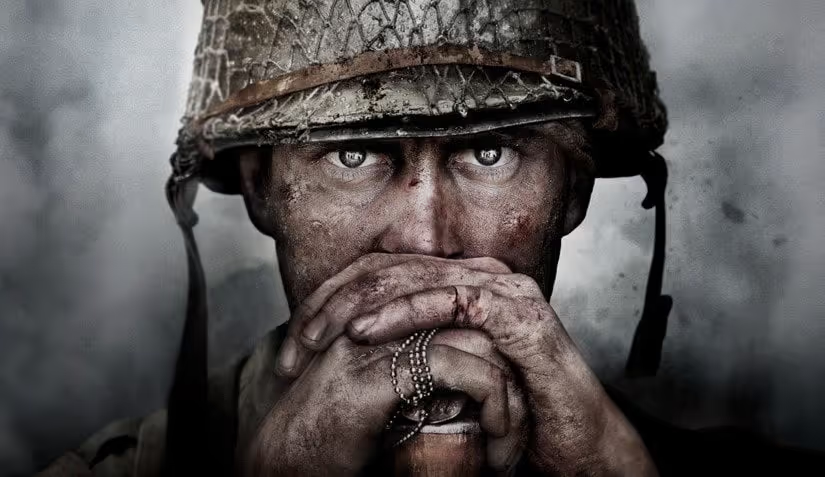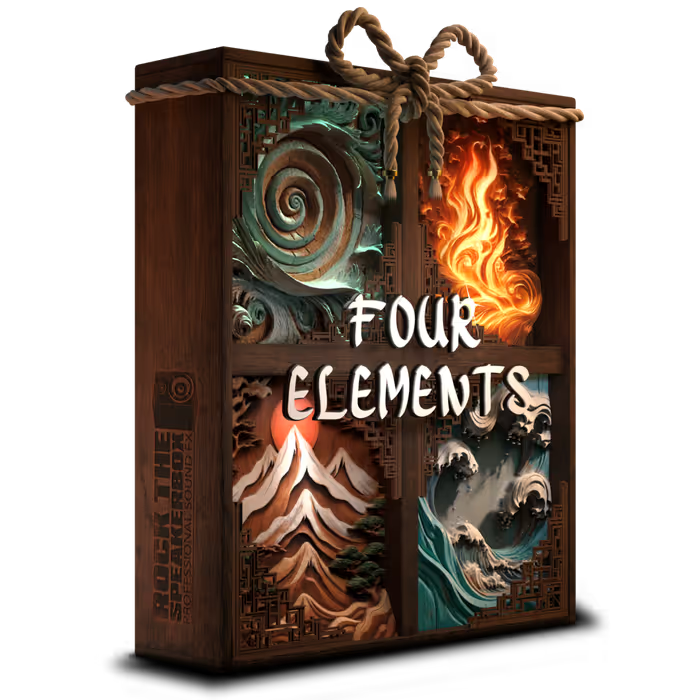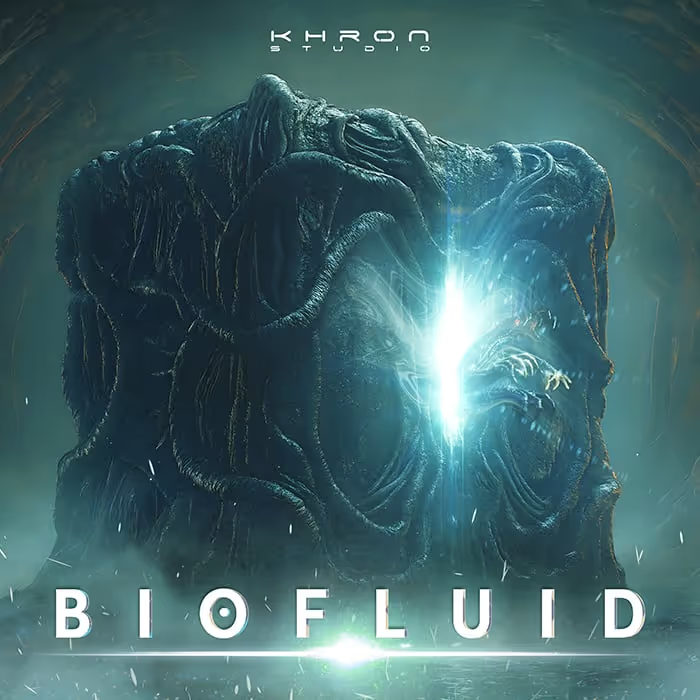The audio team just won a Golden Reel award for Outstanding Achievement in Sound Editing for their work on the game - and in this exclusive A Sound Effect interview, Dave Swenson talks about his approach to the sound and the experience of recording, crafting, and mixing Call of Duty: WWII:
Activision/Sledgehammer Games’ Call of Duty: WWII (released in November 2017) is a boots-on-the-ground, gritty and visceral FPS war experience. There’s a compelling single-player campaign that pushes from the beaches of Normandy to the rubble of Berlin. There are multiplayer modes, and let’s not forget zombie mode! And, Activision/Sledgehammer just released The Resistance: DLC Pack 1, which offers more multiplayer and zombie fun.
Audio Director Dave Swenson wanted the game to feel immersive and authentic to World War II. Every sound was custom recorded for the game, which was quite a task considering that World War II happened nearly 80 years ago. The weapons, gear, and vehicles (both for land and air) are becoming museum pieces, with fewer and fewer intact and functioning specimens. That didn’t stop Swenson. Relying on his resourcefulness and creativity, Swenson managed to track down and record every gun, grenade, tank, plane, and Jeep he needed for the game. Here, he talks about his approach to the sound and the experience of recording, crafting, and mixing Call of Duty: WWII.
So much has changed tech-wise since the previous Call of Duty releases that were set in WWII, but were you able to use anything from those earlier games?
Dave Swenson (DS): A lot has happened in the years since the previous Call of Duty set in World War II. We ended up not being able to use anything that we had used previously. In that way, it meant we really had to start from scratch.
One of the reasons for this is dynamic range. At Sledgehammer Games our goal is to have a very high dynamic range game. For that to work, you need all of your assets in the game to be high dynamic range assets. If you have any assets that are heavily compressed then that will throw a wrench into the whole thing.
There have been great advancements in recording technology since the last Call of Duty set during World War II. We have equipment that record at very high sample rates, allowing us to do a lot more with the assets when we start working with and processing them. We made the decision early on that we wouldn’t use anything that was used previously. We went out and recorded everything new for this game. Everything you hear in Call of Duty: WWII was purposefully recorded for this game. It was all new recordings by our team at Sledgehammer Games.
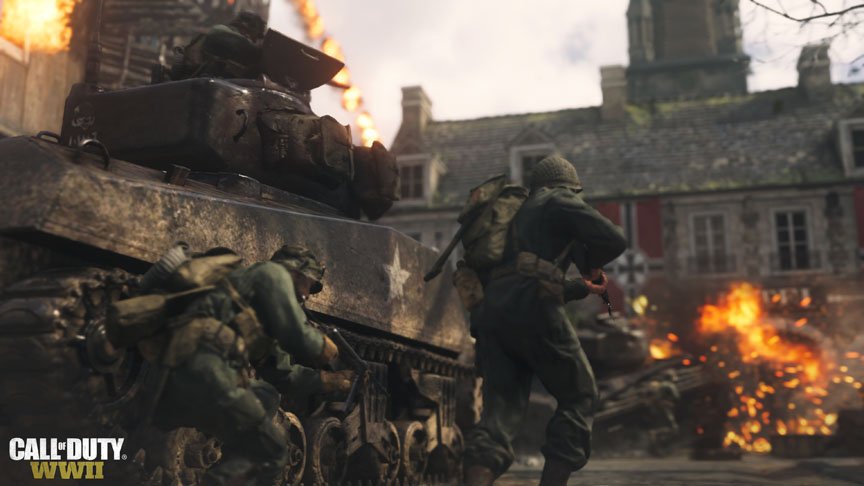
Can you tell me about the field recordings you did for the weapons? Was it difficult to find World War II weapons?
DS: Sledgehammer Games’ previous title was Advanced Warfare. That was the game that we had just finished shipping when we shifted gears and went into WWII. We had all of these great sounds but they were for modern and slightly futuristic weapons. In Advanced Warfare, we had this cool, creative opportunity to make these very neat and original sounds for things that didn’t necessarily exist.
For Call of Duty: WWII, we had the new opportunity and challenge to re-create sounds that did exist, for guns and tanks and planes and weaponry that are real. Of course, we wanted to re-create these sounds as authentically as possible. The tricky thing was finding those guns, tanks, and planes from World War II that are still operational. You can go and see them in a museum, but they aren’t necessarily making any sound. We needed to find working versions of everything.
We worked with a military/historic advisor named Marty Morgan. He’s a World War II expert and he really helped the team at Sledgehammer Games understand the war and become experts ourselves. We were fortunate to have Marty on our team.
He lives just outside of New Orleans and we arranged a trip for my entire audio team to travel down there and spend a week on his property. We painstakingly recorded every single weapon. Because they were his personal guns, we had a lot of time with them. We spent a whole week recording all the sounds they could make, from gunfire sounds, to the Foley sounds, to what they sound like when they reload.
On the range, we placed microphones at numerous distances. We recorded them shooting single shots and multiple shots (automatic). It was a great opportunity. He gave us the chance to record all of the different weapons for all of the different countries that were involved in the conflict.
On the range, we placed microphones at numerous distances. We recorded them shooting single shots and multiple shots (automatic). It was a great opportunity. He gave us the chance to record all of the different weapons for all of the different countries that were involved in the conflict.
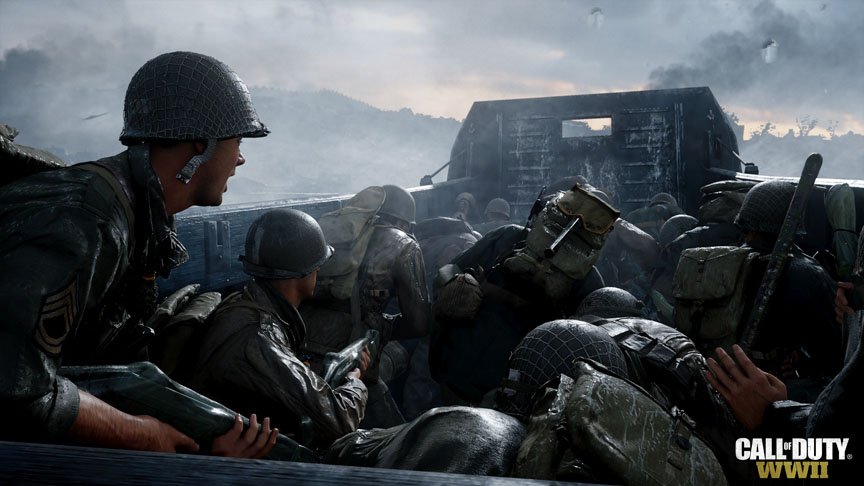
What mics and recorders did you take down to Louisiana with you?
DS: Over the years, our studio has built up a great collection of microphones and recorders. Our primary recorder is the Sound Devices recorder. We have some 702s and some 744 recorders.
Paired with those Sound Devices recorders, we use a variety of mics depending on the application. One of my favorite microphones for recording weapons is the Sennheiser 8040. It’s a great mic for recording high SPL sound sources. You get some great low-end to it and the mic has a great high-frequency response. It does well with high SPL recording. We had about three pairs of the 8040s at our weapon shoots. We also record everything using stereo mic setups.
We were using either X-Y or ORTF configurations, depending on the placement. For example, we might have a pair of 8040s about 6-feet behind the shooter in an ORTF setup, and that allowed us to get a really great overall sound of the shots. You also get a nice wide recording of the report. We also used Schoeps mics, although you have to be careful with them at high SPLs. Using the Schoeps, we set up a spaced pair of Schoeps Colette series with the omnidirectional capsules. Again, it would be a stereo pair but a spaced omni pair. We had the opportunity to experiment, so we also had another Schoeps setup behind the shooter in an M/S configuration. We would record one day and listen to it and then adjust on the next day.
With all the different microphones, what you hear in the final product is an amalgamation of the various microphones based on what we need for the perspective of the sound in-game. The game is a first-person shooter, so we need that perspective. But then we have all of the NPCs firing their weapons from various distances and so we would use recordings from different distances and with different mics to cover all of those moments.
[tweet_box]Creating Call of Duty WWII’s Authentic Sound – an in-depth interview with Dave Swenson[/tweet_box]
I have a secret weapon, my favorite recorder. Occasionally, we will put out behind-the-scenes material and you will see this microphone setup used everywhere that we record. Unfortunately, this device is no longer being made. They stopped making it this past year. It’s this little recorder called a Sony PCM M-10. It’s little, about the size of an iPhone. It’s meant to be a pocket recorder and it sounds great. When it was in production, it only cost about $200. It comes equipped with two little omnidirectional mics. So, we’d mount one of those M-10 recorders on a little suspension system on the boom pole and put a mini Rycote on it, and we’d record like crazy with that thing. We have about a dozen of them in our office. Often we will record with those and with our expensive Sound Devices and Sennheiser setups. Then back in the studio, we will do a blind comparison to find which recordings sound the best. About 75% – 80% of the time, the sound designers would choose the recordings from the Sony PCM M-10. It’s a great recorder if you can get your hands on it. Those things are like gold.
Let’s talk about the vehicle sounds because like the weapons, those WWII tanks, planes, and even Jeeps are getting harder to find in operable condition…
DS: I find, as an Audio Director on a game like this, that I’m constantly working on making relationships with people who have stuff.
The vehicles in our games are very interactive and so we like to have a lot of control over the sound. We try to record the vehicle sounds in layers. For example, if we need to design a tank then we like to get the sound of the tank’s engine separate from the sound of the treads and the metal groans of the tank’s body as it moves around. When we began production, we were trying to figure out how to do that.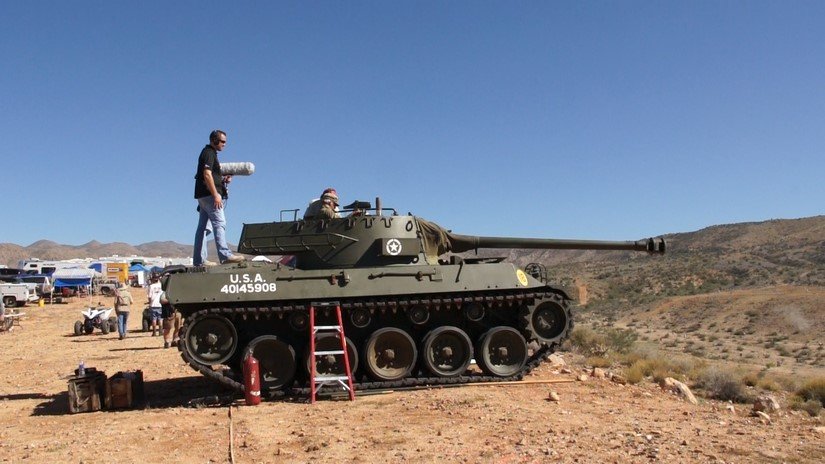
I said, “Hey, I saw your video on YouTube. This isn’t a joke and I’m not trying to prank you, but I work for a video game company and I would really love to come record your engines if that’s possible.”
I have a buddy who owns several tanks — which, again, is very fortunate. I called him and we went out to his place and recorded for a while. We got all of the sounds of the treads tread sounds and the metal groans of the tank, what it sounds like to be in a tank and on top of a tank. But, we couldn’t get the engine as isolated as we wanted it to be. We were doing some searching on did a search on YouTube and we found this video with this professor-looking guy a video by a guy that had just what we were looking for. He had this two-stroke Detroit diesel engine (like they used in the WWII tanks) out on these blocks and he was revving it up for his students. He was making these great rev and drive sounds in total isolation — meaning it wasn’t attached to a vehicle at all. It was perfect.
So I did some Internet sleuthing to find out who this guy he was. Finally, I was able to track down his email and I said, “Hey, I saw your video on YouTube. This isn’t a joke and I’m not trying to prank you, but I work for a video game company and I would really love to come record your engines if that’s possible.” He responded back and he was questioning how authentic I was, but we finally got to a point where he trusted that I wasn’t pulling his leg. Eventually I took my crew out to his place and he pulled out the big engines and we were able to do a recording session with just these engines out on the blocks. We got some great revs, idles and drive sounds.
Once we implemented the sounds into the game, we had a lot of control. We could make the tanks react exactly to the player’s input.
What about the Jeep?
DS: The Willys Jeep is a very iconic Jeep from World War II. We really wanted to make sure that we were super authentic with that. For the Willys Jeep, we were having a hard time finding the right engine. We didn’t want a modified engine or a modern engine. We wanted to be as authentic as possible so we found a place in Los Angeles that owns a whole bunch of military vehicles from different eras and they rent those vehicles out for use in Hollywood films. We arranged for our crew to go and record there with the help of renowned sound effects recordist John Fasal.
We spent the whole day doing an in-depth recording session of the Willys Jeep. We got all the different sounds — from driving to Foley, doors creaking and getting in and out, and changing gears, etc. We brought those recordings back to our studio and cut them up and put them into our interactive system to make the experience in-game as authentic as possible.
The game won a Golden Reel award for Outstanding Achievement in Sound Editing (sharing the honors with the sound team for Star Wars Battlefront 2) – here are the team members:
Audio Director: David Swenson
Audio Leads: Michael Caisley, Don Veca
Sound Designers: Ryan McSweeney, Eric Wedemeyer, Matthew Grimm, Caleb Epps, Eddie Pacheco,
Andrew Lackey, MPSE, Mark Kilborn, Darren Blondin, Andy Bayless, Vadim Nuniyants, Jeremiah Sypult, Brian Johnson, Bob Love
Supervising Dialogue Editors: Emilio Lopez-Centellas, Fernando Labarthe
Lead Dialogue Editors: Adam Boyd, MPSE, David Natale
Dialogue Editors: Joseph Lyford, Jesse Garcia, MPSE, Duncan Brown, Dutch Hill, Micah Loken, MPSE, Dan P. Francis
Audio Artists: Sheridan Willard, Nicholas D’Amato
Supervising Music Editors: Anthony Caruso, Jonathan Mayer
Music Editors: Sam Marshall, Ted Kocher
And the planes?
DS: We went and recorded planes, too. Everything you hear in the game was recorded by us for the game.
The planes were probably the trickiest to get because there are so few of them still in operation. We had to get very creative to get those sounds. I was reading the newspaper one day and I saw that there was this big traveling airshow of World War II bombers and fighter planes. They come to a local airport and do demonstrations and offer rides. You can pay to take a ride in a bomber or the fighter and it’s open to the public. Because they’re giving rides, they are taking off and landing every half-hour or so for eight hours a day. I found out where they were going to be, what airport they’d be at, and asked if we could be out on the runway. Unfortunately, the FAA said that we couldn’t as it was against their regulations.
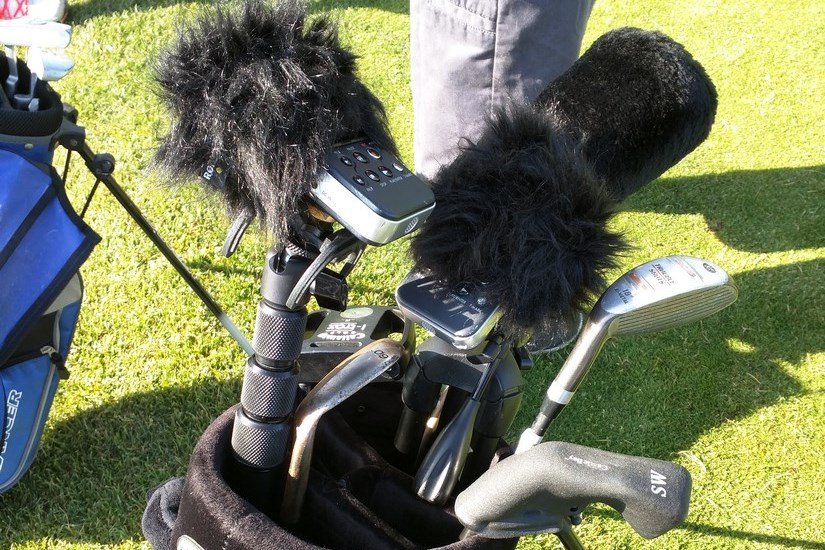
We got a golf cart and we just played Hole 3 all day long. We’d just putt around until we’d see the bomber start to taxi out on the runway to take off.
So, we had to get creative. I took a look at Google Earth and I saw that there was a golf course right at the end of the runway. In fact, Hole 3 was right where they’d fly over. We were separated only by a fence line. It was the perfect positioning. I grabbed a couple of my guys and we drove out on the morning of the airshow and we bought a round of golf. We got a golf cart and we just played Hole 3 all day long. We’d just putt around until we’d see the bomber start to taxi out on the runway to take off. We’d get out the recorders (which we had stashed in our golf bags) and then we would record these great take-offs and fly-overs. Throughout the day they were flying over, landing, and taking off at different speeds and we were able to get all of these great recordings of authentic World War II bombers and fighter planes.
It was also a really quiet location and we didn’t have any noise problems. We didn’t want to record where the airshow was taking place because you’d have to deal with crowds and that would contaminate the recordings — which is why the golf course was perfect.
We also found another place that was doing air races with P-51 Mustangs, which were American fighter planes from World War II. We spent the day capturing fast fly-by sounds.
As I said, we had to be creative about how we got the recordings but we were still able to get everything that we needed.
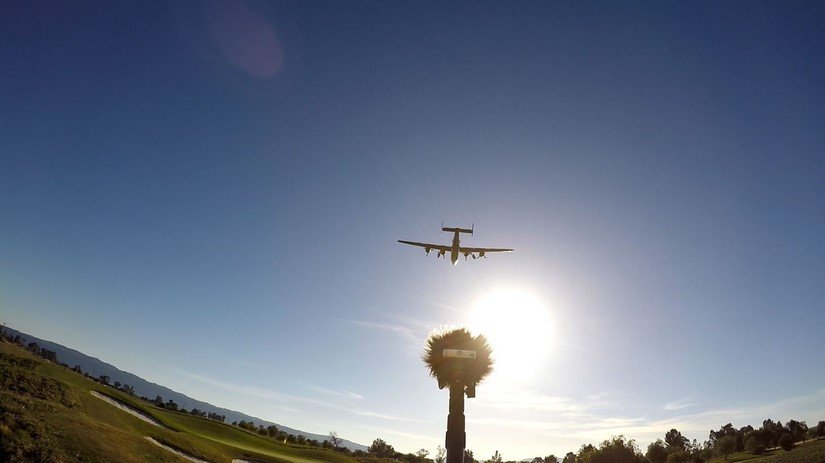
The boots-on-the-ground gameplay style, what did that mean for you in terms of sound? Did you rely a lot on Foley to make that experience so visceral?
DS: There was this trend in Call of Duty of players being up in the air. For instance, in Advanced Warfare, we had the boost jump and that added verticality to the combat. You were constantly boosting up and you could shoot from up high and be in different positions. This brought interesting innovations to the gameplay. However, after a few cycles of that, there was a desire to get back to the boots-on-the-ground gameplay.
What that meant for us sonically was that we wanted the battlefield to sound intense and realistic – like the player is really there. Foley was a huge part of that and we spent a lot of time recording Foley — whether it be the Foley that the player character was making or the Foley that the NPCs were making. We needed all of the Foley to sound authentic and real.
On Advanced Warfare, we found that we were struggling to get the Foley recorded in the studio to sound as open and “in the environment” as we wanted it to sound. Eventually we experimented with going out and doing our Foley recording on location. This technique ended up giving us the exact sound we were looking for. If we needed footsteps in the forest, we’d go to the Redwood forest near our studio and record footsteps. If we needed sounds in a bunker, we’d go and find a bunker and record our sounds there. The natural reverberations of the various locations and how the clothing and props reacted in the actual environments sounded better and more natural to us.
This meant we couldn’t just knock out all of our Foley recording in just one day in the studio. Instead we had to travel to different locations to record. Ultimately the extra effort in recording on location really helped to make the Foley sound just as natural as possible.
Get the story behind the music for Call of Duty WWII, in this Soundworks Collection talk with composer Wilbert Roget II:
We actually spent more time recording and working with debris than we did with recording actual explosions.
In addition to Foley, we spent a lot of time working to make the battlefield feel alive. We recorded explosions and we recorded a lot of debris. The debris was important to us and we actually spent more time recording and working with debris than we did with recording actual explosions. For us, we wanted the explosion to sound punchy and big but it was more about what the explosion was doing to the environment around the player. When you hear an explosion in the game, you hear the rocks ripping and cracking and flying through the air and you hear the sand and debris sprinkling down. We wanted the players to feel like they were in the environment and so that is where we put our focus.
With gameplay that is more centered on the player, who isn’t boosting and jumping around anymore, that boots-on-the-ground/run-and-gun, classic Call of Duty gameplay needed to make the players feel like they were there.

The backgrounds are so alive with danger. We talked about the explosions and the debris. There are also guns firing and bullets whizzing by and ricocheting. There are people yelling orders, people dying, planes flying overhead… What was your approach to designing the world? How did you bring all of these sound elements together to tell the story of what’s happening around the main character Daniels?
DS: We wanted to be very respectful of this conflict. This conflict meant a lot; it changed the world and we recognized that. This was the “Greatest Generation” and we really wanted to pay tribute to the brave men and women who fought in this war. We didn’t want to undersell it and create a watered-down version of World War II, but we also didn’t want to glorify violence or go over the top.
We wanted to get it as accurate as possible so we leaned on our military/historic advisor Marty Morgan to help us understand the details of the war. For example, what was happening on Normandy Beach when they were landing? What would the soldiers hear? Were they doing a lot of shooting themselves? Were they mostly just trying to find cover from the MG 42 machine guns that Germans were firing at them from the bluffs above? He would tell us stories and talk to us about real experiences of the soldiers and that would help my team to understand what it might have sounded like.
We’d have days that we would bring Marty into the studio and we’d play a level for him that we created, and ask him what he thought. Are we close? Are we getting this right? Marty would give us a whole list of notes. He never pulled punches. He was always forthright with his feedback. He’d say that we weren’t getting this right or that right and he’d give us specific notes on how to change it. Then we would go back to work.
The dialogue followed the same process — like the battle chatter and yells you hear during combat. We’d ask him what the soldiers would be saying and we’d write scripts and send them to him. He’d correct us all the time on what they’d be saying. We really leaned on him and we were always open to making the changes that he suggested. I wouldn’t want a World War II veteran to sit down and experience the game and say, “That’s not what it was like.” That would be a real failure for me. My hope would be that a World War II veteran would say, “Yeah, that’s exactly what it was like.” That was our goal and that’s why we put in all of the effort that we did.
From a technical standpoint, how did you accomplish that? I know you use a proprietary game engine; do you also have proprietary audio tools that work with that?
DS: For me, as the audio director, I look for sound designers who can not only handle all the recording and sound design, but who also know how to do the implementation. Our sound designers aren’t taking the great sounds they make and throwing them over the fence to the engineers to do all the scripting and coding to get the sounds into the game and working. All of our sound designers at Sledgehammer Games do that themselves. Our implementation relies on a robust scripting language. It requires our sound designers to be highly technical, to be almost like audio programmers.
When we hire sound designers, we understand that we use a proprietary system and a proprietary language and no one is going to have experience with it. We know that’s something we can teach. Therefore, when interviewing, we first and foremost look for someone who is a great sound designer; who has a talent for recording and designing. Then we look for candidates who have a desire to be technical. As long as they have the interest, we can make them very technical with some on-the-job training. Ultimately, we need the whole team to be expert sound designers and also expert technical sound designers and implementers.
Our team is very important. We need the right team of people who are both very artistic and very technical. I feel like we were very lucky in building our team. Each sound designer is the best of both worlds. Once you have that, then it’s just a matter of doing a lot of work. We went out and captured all of these great assets, got them to sound the way we wanted them to sound in the DAW, but then pushed that over into the game and got them to sound in-game the way it sounded in Pro Tools or Reaper. The reality is, our sound designers use their DAWs only as a pre-mix or rough-edit. Most of the time they use the game itself as their DAW. When we are implementing sounds, we are implementing them in multiple layers so that we have the flexibility in-game to do real-time and runtime mixing and layering of assets based on the situation. To get to a high level of quality you need the right set of talent doing a lot of hard work.
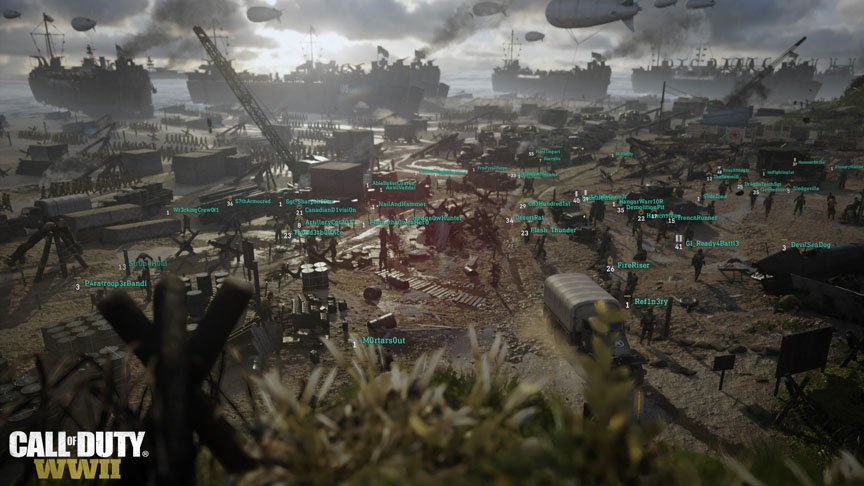
For the performance-capture scenes (the scripted scenes that happen intermittently throughout a campaign), how do you get the transitions in and out of those to sound so smooth?
Because it’s in-game, the ambiences and the music continue to run through those performance-capture scenes and that provides the glue that holds it all together and makes it sound consistent.
DS: We’re going for a very transparent change there. We want those moments to flow and to not pull the player out of the story. The way we accomplish that is by approaching those scenes in the same way that we approach any other audio in the game. As I mentioned previously, our sound designers use the game-engine as their primary DAW. Instead of sound designing those scenes in a DAW and then printing linear tracks that just play under the scene, we treat those sequences as gameplay. When we go into those moments and there’s great Foley happening, that’s the same Foley you would hear in regular gameplay. The same sound designers that work on gameplay also designed those scenes. Because it’s in-game, the ambiences and the music continue to run through those performance-capture scenes and that provides the glue that holds it all together and makes it sound consistent. Everything is layered in just like we’d do for gameplay and in that way, we hope to make it sound as transparent as possible.
Let’s talk about the Nazi zombies. It seems like such a fun mode for you guys to design. Can you tell me about your zombie sounds?
DS: Sledgehammer Games was started by the team who made the original Dead Space game. Myself and some of the other senior sound designers on the team were also part of the Dead Space audio team and that’s true for the game designers and animators and artists. So really, the DNA of the studio is making horror games. That’s where we got our start together. Because of that, we really love it. To jump into a horror game mode and go back to our roots, that was a fun opportunity.
The zombies in Call of Duty: WWII were recently deceased German soldiers so they’re very human. There have been some alterations by Dr. Doktor Straub, the an evil German scientist, and he’s created some crazy zombies, but ultimately, they start out as recently deceased soldiers. Therefore, the basis of the design was to start with human sounding recordings and then experiment with different ways to make them sound scarier, or give them that hint of horror.
We got some of the sound designers in the VO booth and had them make crazy zombie-type sounds and then we experimented on how to process those with plug-ins and tools to make them sound beastly and scary. Once we found what we were looking for, we cast a couple of vocal artists who were good at making crazy, creature, zombie-type sounds. We spent several days in the studio in L.A. recording these talented artists and that gave us this great base layer of content.
Don Veca (also a Dead Space alumni) had this idea to make a language for the zombies. I’m not sure how many fans figured this out but the zombies actually have their own language that they stick to. They’re Germans, but they’re not speaking German because they’re dead and they’re zombies. So, Don created this language that he called “Zom-Deutsche,” and it’s made from actual German dialogue — the writers would write dialogue for the zombies in German. Don then wrote a program (all of our sound designers being very technical and able to script and program) that would swap syllables around and scrambled the syllables of the language up just enough to have it not be clear German, but it still had the feeling of being German. We would then hire German actors, who spoke German well, and we would put these Zom-Deutsche scripts in front of them. They’d look at them like, “What is this?” We’d ask them to read the script as if they were speaking German but it would really sound like gibberish to them. They would give it a couple practice shots and then they’d perform it in a more gruff, zombie-esque performance. It turned out great. We have all of these great recordings of this dialogue that we wrote for the zombies, that sounds very German but isn’t actually German.
There’s so much fun stuff in this mode, like the electric shock wave and zombies on fire! Underground, there’s a lovely heavy atmosphere and flies buzzing around, and the guns sound beefier in that space…
DS: We have in-game reverb happening, so when you go to different environments, like underground, you get this different reverb setting. The weapons will react to that and sound appropriate for that space. So underground, it’s like you’re in a bunker or a tunnel and the weapons sound louder and have a reverberation that builds up when the player is firing.
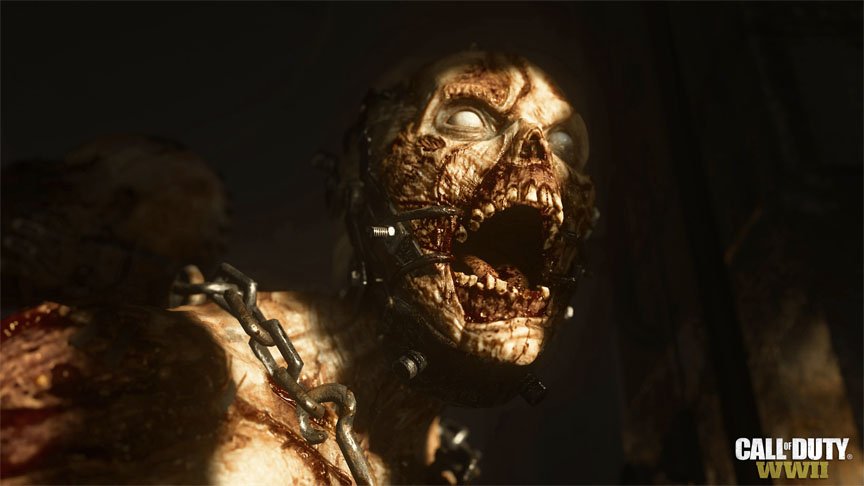
What was your biggest challenge in terms of sound on Call of Duty: WWII?
DS: One of the biggest challenges was just getting it all done. There’s so much in here, like the zombies mode and multiplayer and the single-player campaign. They are all a little bit unique.
The game has a lot of content and we had a huge desire to make everything great. That was time-consuming. It was a lot of work to get it all done. But fortunately, our team is very selfless and they put in the extra work and the long hours to make that happen.
As far as technical hurdles, we have a lot of flexibility with our game engine which is great. But, that flexibility requires technical expertise and the time to make things happen. As a sound designer, if I need a feature or a certain interactive system in the game, I will just script that myself. With our engine, I have the opportunity and the ability and the flexibility to do that. That’s awesome. But the price we pay for that is time. It takes time and we must plan and prepare for that.
How long did you have to work on this game?
DS: Call of Duty: WWII was a three-year production cycle. From start to finish, we had about three years.
In single-player mode, what was the most challenging campaign to design? Why?
DS: That’s tough. Each one had its unique challenges. But right off the bat, one of the first levels we created was Normandy. That had an interesting challenge because of a film called Saving Private Ryan. It’s been about two decades since its release, but their Normandy sequence was known as having some of the best sound design ever, particularly for a war film. We were creating our own Normandy Beach landing and we were very intimidated as a sound design team. We knew that our audience already had in their minds a memory of this great sounding film sequence. They know what a great Normandy sequence sounds like because of Saving Private Ryan. Therefore, that was a daunting task. We spent a lot of time watching and listening to Saving Private Ryan and talking about how we could give that our own twist. What could we do to make it better?
We were thinking about the explosions on the beach and what they were doing to the environment around the player. That led us to go to a beach and take a bunch of helmets with us. We’d throw sand up into the air and record that sprinkling down onto and into the helmets. In the game, as our players are running up the beach and explosions are happening around them, they hear the sand and debris falling onto their helmets. It had a great result of pulling you into the world and making you feel like you were there, which was the intention of the moment. It was exciting to work on the Normandy Beach sequence but it was challenging because there were really high expectations.
Another challenging level was the Paris level, which is the espionage/stealth level. In that level we shift from the action-packed, high action, classic Call of Duty to this quiet, espionage/stealth level. This presented a challenge because it was different and unique for what is common in this franchise. We had to look at ways to build up tension using the sound design, music, and dialogue; all of those elements working together to build the tension and be an exciting level even without all of the typical explosions and gunfire.
There were also some really big sequences to deal with. Those are fun and challenging because they take a lot of work. We had the Marigny level when the whole church collapses around you. The bell tower is collapsing and the sound design for that whole sequence was really fun to do. Obviously, we didn’t have a church we could destroy nor huge bells that we could drop down multiple stories. It took a lot of recording, capturing things like mufflers and tailpipes of cars clanging against each other and striking pots with big metal objects. Then processing those recordings to make them sound bigger and sound like bells clanging and falling. We recorded various debris, like rock ripping sounds.
Everywhere you turn is a challenging sequence but that’s what makes it fun and enjoyable to work on a game like this. This is definitely not a game where we slapped a new coat of paint on the old stuff and then shipped it. Everything is custom and built from scratch and that’s what makes it exciting to work on; new challenges around every corner.
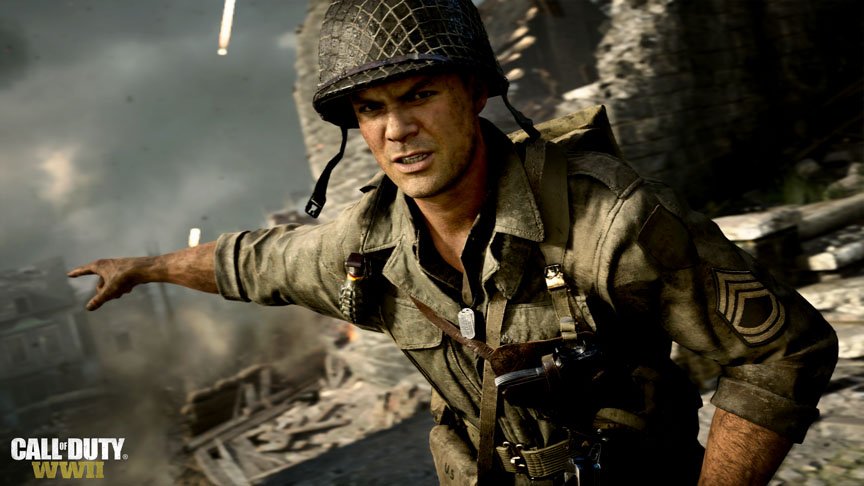
What are you most proud of, sound-wise, on Call of Duty: WWII?
Even with all the chaos of the battles, and as crazy as Call of Duty can get in terms of gameplay, the mix is always clean and you hear all of the individual elements.
DS: There are a couple of things. The mix is something we’re very proud of. The mix is really hard in a game like this because there’s so much wall-to-wall action. There are some really great games that have an opportunity to settle things down and have palate cleansers pretty frequently. But Call of Duty isn’t necessarily designed like that. So you have the potential to have a mix that is very busy and could really turn into a “wall of sound.” You can easily fall into the trap of wanting to put a sound on everything. With so much going on, it can end up being too much. It can be unclear and not focused. One thing we take pride in here at Sledgehammer Games, and one of our number one concerns is to have a very clean and focused mix. Even with all the chaos of the battles, and as crazy as Call of Duty can get in terms of gameplay, the mix is always clean and you hear all of the individual elements. You can hear the bullets whizzing by. You can hear the individual guns and the explosions. You can hear the Foley, and the dialogue, and the music. Nothing steps on each other or gets in the way of each other or competes with each other.
One thing we did to help that was to make the conscious choice to not use any percussion in the music because in previous games we realized that the percussion in the music was competing with the percussive nature of the sound design. You have machine guns that sound an awful lot like snare drums. We have explosions that sound an awful lot like a low bass drum. When you have all that percussion going on at the same time as the machine guns and explosions, they start to compete with each other. Early-on we made the choice not to have any percussion in the music so that there would be no competition with the guns and explosions. Instead, those elements are supporting each other in the mix.
I’m very proud that we were able to maintain a very clean, highly dynamic sound and focused mix in the middle of a game like this where there’s wall to wall action. The final mix, which happens in-game, was done by myself and my lead sound designer Michael Caisley. Near the end of the project we would sit together in my room and play each level hundreds of times. We would go through and listen to every possible scenario and fine-tune every element in the mix so that everything sounds great. If a sound doesn’t need to be there, then we back it off in the mix so that it gets out of the way of something else. It’s a time-consuming process, which takes about a month or two at the very end of the project, but it’s time well spent.
A big thanks to Dave Swenson for giving us a look at the exciting sound in Call of Duty: WWII – and to Jennifer Walden for the interview!

